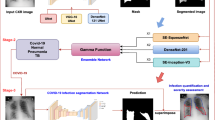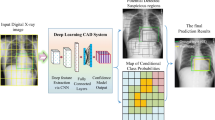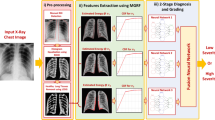Abstract
Automatic computer-aided diagnosis (CAD) system has been widely used as an assisting tool for mass screening and risk assessment of infectious pulmonary diseases (PDs). However, such a system still lacks clinical acceptability and trust due to the integration gap between the patient’s metadata, radiologist feedback, and the CAD system. This paper proposed three integration frameworks, namely—direct integration (DI), rule-based integration (RBI), and weight-based integration (WBI). The proposed framework helps clinicians diagnose lung inflammation and provide an end-to-end robust diagnostic system. Initially, the feasibility of integrating patients’ symptoms, clinical pathologies, and radiologist feedback with CAD system to improve the classification performance is investigated. Subsequently, the patient’s metadata and radiologist feedback are integrated with the CAD system using the proposed integration frameworks. The proposed method’s performance is evaluated using a private dataset consisting of 70 chest X-ray (CXR) images (31 COVID-19, 14 other diseases, and 25 normal). The obtained results reveal that the proposed WBI achieved the highest classification performance (accuracy = 98.18%, F1 score = 97.73%, and Matthew’s correlation coefficient = 0.969) compared to DI and RI. The generalization capability of the proposed framework is also verified from an external validation set. Furthermore, the Friedman average ranking and Shaffer and Holm post hoc statistical methods reveal the obtained results’ statistical significance.
Graphical abstract
Methodological diagram of proposed integration frameworks








Similar content being viewed by others
Notes
Pt. Jawahar Lal Nehru Memorial Medical College, Raipur, Chhattisgarh, India. Website: https://ptjnmcraipur.in/
References
Filho PPR, Barros ACdS, Ramalho GLB et al (2019) Automated recognition of lung diseases in CT images based on the optimum-path forest classifier. Neural Comput Appl 31:901–914. https://doi.org/10.1007/s00521-017-3048-y
Chouhan V, Singh SK, Khamparia A, et al (2020) A novel transfer learning based approach for pneumonia detection in chest X-ray images. Appl Sci 10https://doi.org/10.3390/app10020559
(2019) Global Tuberculosis Report 2019. In: World Heal. Organ. https://www.who.int/tb/publications/global_report/en/. Accessed 13 Mar 2020
(2020) WHO Coronavirus Disease (COVID-19) Dashboard. In: World Heal. Organ. https://covid19.who.int/. Accessed 16 Oct 2020
Jorritsma W, Cnossen F, Van Ooijen PMA (2015) Improving the radiologist-CAD interaction: designing for appropriate trust. Clin Radiol 70:115–122. https://doi.org/10.1016/j.crad.2014.09.017
Chandra TB, Verma K, Singh BK et al (2020) Automatic detection of tuberculosis related abnormalities in chest X-ray images using hierarchical feature extraction scheme. Expert Syst Appl 158:113514. https://doi.org/10.1016/j.eswa.2020.113514
Nguyen DCT, Benameur S, Mignotte M, Lavoie F (2018) Superpixel and multi-atlas based fusion entropic model for the segmentation of X-ray images. Med Image Anal 48:58–74. https://doi.org/10.1016/j.media.2018.05.006
Pinto A (2010) Spectrum of diagnostic errors in radiology. World J Radiol 2:377. https://doi.org/10.4329/wjr.v2.i10.377
Chandra TB, Verma K, Singh BK et al (2021) Coronavirus disease (COVID-19) detection in Chest X-Ray images using majority voting based classifier ensemble. Expert Syst Appl 165:113909. https://doi.org/10.1016/j.eswa.2020.113909
Sverzellati N, Milanese G, Milone F et al (2020) Integrated radiologic algorithm for COVID-19 pandemic. J Thorac Imaging 35:228–233. https://doi.org/10.1097/RTI.0000000000000516
Zhang K, Liu X, Shen J et al (2020) Clinically applicable AI system for accurate diagnosis, quantitative measurements, and prognosis of COVID-19 pneumonia using computed tomography. Cell 181:1423-1433.e11. https://doi.org/10.1016/j.cell.2020.04.045
Welter P, Fischer B, Günther RW, Deserno (né Lehmann) TM (2012) Generic integration of content-based image retrieval in computer-aided diagnosis. Comput Methods Programs Biomed 108:589–599. https://doi.org/10.1016/j.cmpb.2011.08.010
Singh BK, Verma K, Panigrahi L, Thoke AS (2017) Integrating radiologist feedback with computer aided diagnostic systems for breast cancer risk prediction in ultrasonic images: an experimental investigation in machine learning paradigm. Expert Syst Appl 90:209–223. https://doi.org/10.1016/j.eswa.2017.08.020
Zhu L, Gao G, Liu Y et al (2020) Feasibility of integrating computer-aided diagnosis with structured reports of prostate multiparametric MRI. Clin Imaging 60:123–130. https://doi.org/10.1016/j.clinimag.2019.12.010
Ai T, Yang Z, Hou H et al (2020) Correlation of chest CT and RT-PCR testing for coronavirus disease 2019 (COVID-19) in China: a report of 1014 cases. Radiology 296:E32–E40. https://doi.org/10.1148/radiol.2020200642
Nair A, Rodrigues JCL, Hare S et al (2020) A British Society of Thoracic Imaging statement: considerations in designing local imaging diagnostic algorithms for the COVID-19 pandemic. Clin Radiol 75:329–334. https://doi.org/10.1016/j.crad.2020.03.008
Chen N, Zhou M, Dong X et al (2020) Epidemiological and clinical characteristics of 99 cases of 2019 novel coronavirus pneumonia in Wuhan, China: a descriptive study. Lancet 395:507–513. https://doi.org/10.1016/S0140-6736(20)30211-7
Anthimopoulos M, Christodoulidis S, Ebner L et al (2016) Lung pattern classification for interstitial lung diseases using a deep convolutional neural network. IEEE Trans Med Imaging 35:1207–1216. https://doi.org/10.1109/TMI.2016.2535865
Le NTT, Robinson J, Lewis SJ (2015) Obese patients and radiography literature: what do we know about a big issue? J Med Radiat Sci 62:132–141. https://doi.org/10.1002/jmrs.105
Dr Graham Lloyd-Jones Chest X-ray Anatomy - Soft tissues. https://www.radiologymasterclass.co.uk/tutorials/chest/chest_home_anatomy/chest_anatomy_page10. Accessed 24 Sep 2020
Chandra TB, Verma K (2020) Analysis of quantum noise-reducing filters on chest X-ray images: a review. Measurement 153:107426. https://doi.org/10.1016/j.measurement.2019.107426
Sharma R, Sharma S, Pawar S et al (2015) Radiation dose to patients from X-ray radiographic examinations using computed radiography imaging system. J Med Phys 40:29. https://doi.org/10.4103/0971-6203.152244
Oh Y, Park S, Ye JC (2020) Deep learning COVID-19 features on CXR using limited training data sets. IEEE Trans Med Imaging 0062:1–1. https://doi.org/10.1109/tmi.2020.2993291
Li L, Qin L, Xu Z et al (2020) Using artificial intelligence to detect COVID-19 and community-acquired pneumonia based on pulmonary CT: evaluation of the diagnostic accuracy. Radiology 296:E65–E71. https://doi.org/10.1148/radiol.2020200905
Chandra TB, Verma K (2020) Pneumonia detection on chest X-ray using machine learning paradigm. In: Chaudhuri BB, and Nakagawa M, and Khanna P, and Kumar S (eds) Proceedings of Third International Conference on Computer Vision & Image Processing. Springer Singapore, pp 21–33. https://doi.org/10.1007/978-981-32-9088-4_3
Chandra TB, Verma K, Jain D, Netam SS (2020) Localization of the suspected abnormal region in chest radiograph images. In: 2020 First International Conference on Power, Control and Computing Technologies (ICPC2T). IEEE, pp 204–209. https://doi.org/10.1109/ICPC2T48082.2020.9071445
Ke Q, Zhang J, Wei W et al (2019) A neuro-heuristic approach for recognition of lung diseases from X-ray images. Expert Syst Appl 126:218–232. https://doi.org/10.1016/j.eswa.2019.01.060
Jaiswal AK, Tiwari P, Kumar S et al (2019) Identifying pneumonia in chest X-rays: a deep learning approach. Meas J Int Meas Confed 145:511–518. https://doi.org/10.1016/j.measurement.2019.05.076
Li X, Shen L, Luo S (2018) A solitary feature-based lung nodule detection approach for chest X-ray radiographs. IEEE J Biomed Heal Informatics 22:516–524. https://doi.org/10.1109/JBHI.2017.2661805
Rajpurkar P, Irvin J, Zhu K, et al (2017) CheXNet: radiologist-level pneumonia detection on chest X-rays with deep learning. arXiv Prepr arXiv171105225 3–9
Grewal M, Srivastava MM, Kumar P, Varadarajan S (2018) RADnet: tadiologist level accuracy using deep learning for hemorrhage detection in CT scans. Proc - Int Symp Biomed Imaging 2018-April:281–284. https://doi.org/10.1109/ISBI.2018.8363574
Candemir S, Jaeger S, Palaniappan K et al (2014) Lung segmentation in chest radiographs using anatomical atlases with nonrigid registration. IEEE Trans Med Imaging 33:577–590. https://doi.org/10.1109/TMI.2013.2290491
Chandra TB, Verma K, Jain D, Netam SS (2021) Segmented lung boundary correction in chest radiograph using context-aware adaptive scan algorithm. In: Proceedings of ICBEST 2018. Springer, Singapore, pp 263–275. https://doi.org/10.1007/978-981-15-6329-4_23
Travis WD, Brambilla E, Noguchi M et al (2011) International association for the study of lung cancer/American Thoracic Society/European Respiratory Society international multidisciplinary classification of lung adenocarcinoma. J Thorac Oncol 6:244–285. https://doi.org/10.1097/JTO.0b013e318206a221
Taran S (2010) An examination of the factors contributing to poor communication outside the physician-patient sphere. McGill J Med 13:86–91
Kain Z (2017) Effects of the poor communication in hospitals | The Healthcare Guys. https://www.healthcareguys.com/2017/12/04/effects-of-the-poor-communication-in-hospitals/. Accessed 12 Oct 2020
Sorace J, Aberle DR, Elimam D, et al (2012) Integrating pathology and radiology disciplines: An emerging opportunity? BMC Med 10https://doi.org/10.1186/1741-7015-10-100
Awai K, Murao K, Ozawa A et al (2004) Pulmonary nodules at chest CT: effect of computer-aided diagnosis on radiologists’ detection performance. Radiology 230:347–352. https://doi.org/10.1148/radiol.2302030049
Taylor P, Given-Wilson R, Champness J et al (2004) Assessing the impact of CAD on the sensitivity and specificity of film readers. Clin Radiol 59:1099–1105. https://doi.org/10.1016/j.crad.2004.04.017
Shiraishi J, Abe H, Li F et al (2006) Computer-aided diagnosis for the detection and classification of lung cancers on chest radiographs. ROC Analysis of Radiologists’ Performance. Acad Radiol 13:995–1003. https://doi.org/10.1016/j.acra.2006.04.007
White CS, Pugatch R, Koonce T et al (2008) Lung nodule CAD software as a second reader. Acad Radiol 15:326–333. https://doi.org/10.1016/j.acra.2007.09.027
Nishikawa RM, Schmidt RA, Linver MN et al (2012) Clinically missed cancer: how effectively can radiologists use computer-aided detection? Am J Roentgenol 198:708–716. https://doi.org/10.2214/AJR.11.6423
Kashikura Y, Nakayama R, Hizukuri A et al (2013) Improved differential diagnosis of breast masses on ultrasonographic images with a computer-aided diagnosis scheme for determining histological classifications. Acad Radiol 20:471–477. https://doi.org/10.1016/j.acra.2012.11.007
Yanase J, Triantaphyllou E (2019) The seven key challenges for the future of computer-aided diagnosis in medicine. Int J Med Inform 129:413–422. https://doi.org/10.1016/j.ijmedinf.2019.06.017
Ambroise C, McLachlan GJ (2002) Selection bias in gene extraction on the basis of microarray gene-expression data. Proc Natl Acad Sci 99:6562–6566. https://doi.org/10.1073/pnas.102102699
Srinivasan G, Shobha G (2008) Statistical texture analysis. In: Proceedings of world academy of science, Engineering and technology. pp 1264–1269
Gomez W, Pereira WCA, Infantosi AFC (2012) Analysis of co-occurrence texture statistics as a function of gray-level quantization for classifying breast ultrasound. IEEE Trans Med Imaging 31:1889–1899. https://doi.org/10.1109/TMI.2012.2206398
Haralick RM, Shanmugam K, Dinstein I (1973) Textural features for image classification. IEEE Trans Syst Man Cybern SMC 3:610–621. https://doi.org/10.1109/TSMC.1973.4309314
Albregtsen F (2008) Statistical texture measures computed from gray level coocurrence matrices. Image Process Lab Dep informatics, Univ oslo 5https://doi.org/10.5209/ARIS.6586
Santosh KC, Antani S (2018) Automated chest X-ray screening: can lung region symmetry help detect pulmonary abnormalities? IEEE Trans Med Imaging 37:1168–1177. https://doi.org/10.1109/TMI.2017.2775636
Batool FE, Attique M, Sharif M et al (2020) Offline signature verification system: a novel technique of fusion of GLCM and geometric features using SVM. Multimed Tools Appl. https://doi.org/10.1007/s11042-020-08851-4
Mirjalili S, Mirjalili SM, Lewis A (2014) Grey wolf optimizer Adv Eng Softw 69:46–61. https://doi.org/10.1016/j.advengsoft.2013.12.007
Vapnik V (1998) Statistical learning theory. 1998. Wiley, New York
Pantazi XE, Moshou D, Bochtis D (2020) Artificial intelligence in agriculture. In: Intelligent Data Mining and Fusion Systems in Agriculture. Elsevier, pp 17–101
Khatami A, Khosravi A, Nguyen T et al (2017) Medical image analysis using wavelet transform and deep belief networks. Expert Syst Appl 86:190–198. https://doi.org/10.1016/j.eswa.2017.05.073
Han J, Kamber M, Pei J (2012) Data mining: concepts and techniques
Snoek J, Larochelle H, Adams RP (2012) Practical Bayesian optimization of machine learning algorithms. Curran Associates, Inc.
Triantaphyllou E (2000) Multi-criteria decision making methods. Springer, Boston, MA, pp 5–21
Šaparauskas J, Zavadskas EK, Turskis Z (2011) Selection of facade’s alternatives of commercial and public buildings based on multiple criteria. Int J Strateg Prop Manag 15:189–203. https://doi.org/10.3846/1648715X.2011.586532
Shaffer JP (1986) Modified sequentially rejective multiple test procedures. J Am Stat Assoc 81:826–831
Holm S (1979) A simple sequentially rejective multiple test procedure. Scand J Stat 6:65–70
Demšar J (2006) Statistical comparisons of classifiers over multiple data sets. J Mach Learn Res 7:1–30
Acknowledgements
The authors thank Dr. Satyabhuwan Singh Netam and Dr. Deepak Jain, Department of Radiodiagnosis, Pt. Jawaharlal Nehru Memorial Medical College, Raipur (C.G.), India, and Dr. Sujit Kumar Samanta, Department of Mathematics, National Institute of Technology Raipur, Chhattisgarh, India for their valuable guidance and suggestions.
This study uses the chest X-ray images and the patient histopathological information collected from Pt. Jawaharlal Nehru Memorial Medical College, Raipur (C.G.), India. The necessary ethical permissions (Letter Dispatch No. 13767, Dated: 09/12/2020 and Ethical Approval No.: NITRR/IEC/2019/08, Dated: 12/09/2019) have been obtained prior to the data collection from the competent authorities of both organizations.
Author information
Authors and Affiliations
Corresponding author
Ethics declarations
Competing interests
The authors declare no competing interests.
Additional information
Publisher's Note
Springer Nature remains neutral with regard to jurisdictional claims in published maps and institutional affiliations.
Rights and permissions
About this article
Cite this article
Chandra, T.B., Singh, B.K. & Jain, D. Integrating patient symptoms, clinical readings, and radiologist feedback with computer-aided diagnosis system for detection of infectious pulmonary disease: a feasibility study. Med Biol Eng Comput 60, 2549–2565 (2022). https://doi.org/10.1007/s11517-022-02611-2
Received:
Accepted:
Published:
Issue Date:
DOI: https://doi.org/10.1007/s11517-022-02611-2




